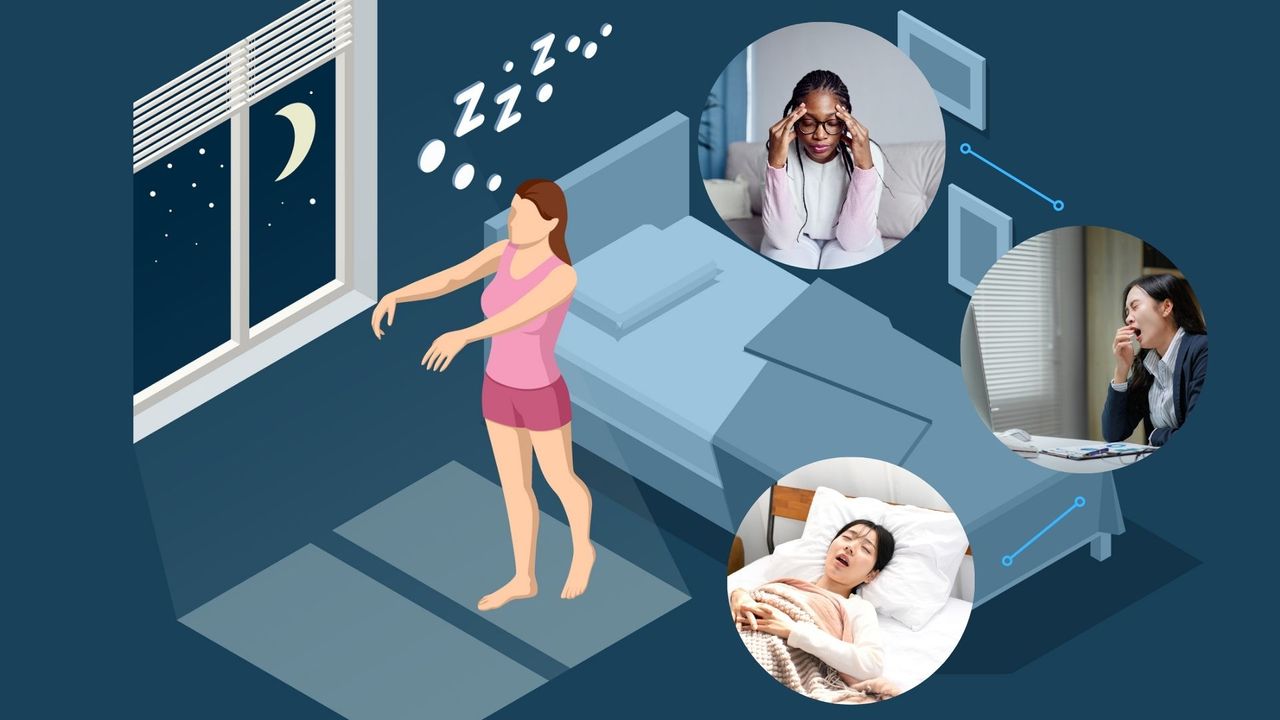Health
Understanding Sleepwalking: Causes, Symptoms, and Solutions

Sleepwalking, a complex sleep disorder, can lead individuals to engage in activities while still in a deep state of non-REM sleep. This unsettling condition can involve walking around the house, performing tasks like eating or watching television, and even experiencing symptoms such as insomnia and daytime sleepiness. In a recent discussion, experts provided insights into common triggers for sleepwalking and suggested ways to manage the condition.
What is Sleepwalking?
Sleepwalking, also known as somnambulism, occurs when an individual gets up and moves around while still in a deep sleep stage. According to UKCP psychotherapist Heather Darwall-Smith, sleepwalkers are not fully conscious. “You’re in a state of dissociated consciousness, where a part of the brain is awake enough to perform complex actions, while the rest remains in a deep sleep state,” she explains. This phenomenon is more prevalent among children and often runs in families, leaving partners and family members alarmed, as the sleepwalker has no memory of the event upon waking.
Symptoms of sleepwalking can vary significantly. They may include sitting up in bed, walking around, performing routine tasks, talking or mumbling, and displaying a blank expression. Some individuals may not even realize they are sleepwalking, particularly if they live alone. Symptoms experienced while awake such as insomnia, headaches, or unexplained injuries may indicate previous sleepwalking episodes.
Common Triggers for Sleepwalking
Several factors can contribute to sleepwalking, with stress and anxiety being significant instigators. Darwall-Smith notes that elevated cortisol levels from stress can disrupt normal sleep patterns. This disruption can lead to fragmented sleep, increasing the likelihood of partial arousals from deep sleep, which is the neurophysiological basis of sleepwalking.
Sleep deprivation also plays a crucial role. When individuals miss sleep, their bodies compensate by increasing deep NREM sleep in subsequent cycles. This deeper sleep can heighten susceptibility to the partial arousals that characterize sleepwalking.
Genetic predisposition is another factor. Research indicates a strong genetic component to sleepwalking, with studies showing that individuals with a first-degree relative who has experienced the condition are at a higher risk. Current research continues to explore the specific genes involved.
Certain medications are known to trigger sleepwalking as well. A 2018 study identified 29 medications across several classes, including benzodiazepines and antidepressants, that may contribute to the condition. The strongest associations were found with drugs like zolpidem and sodium oxybate, which alter sleep architecture.
Additionally, sleepwalking is frequently associated with other sleep disorders, particularly obstructive sleep apnea (OSA). This condition can cause frequent brief arousals during sleep, potentially triggering episodes of sleepwalking, while effective treatment of OSA often resolves sleepwalking occurrences.
Managing Sleepwalking: Lifestyle Changes
For those experiencing sleepwalking, several lifestyle changes can help reduce or eliminate episodes. However, if symptoms become more frequent or severe, it’s essential to consult a healthcare professional.
Improving sleep hygiene is a primary step. Darwall-Smith recommends establishing a consistent and relaxing bedtime routine to signal to the body that it is time to sleep. Creating an environment that is dark, quiet, and cool can also promote deeper sleep and reduce the likelihood of arousals.
Managing stress through simple techniques can have a significant impact on sleep quality. Regular breaks during the day, mindfulness practices, and deep breathing exercises can help regulate the nervous system and reduce hyperarousal, ultimately lowering the risk of sleepwalking.
Reducing or eliminating alcohol intake is another effective strategy. While alcohol may initially seem to promote sleep, it can disrupt sleep architecture and increase awakenings, thereby triggering sleepwalking episodes.
Maintaining a consistent sleep schedule is crucial. Going to bed and waking up at the same time each day can help regulate the body’s internal clock. Establishing a consistent wake time is particularly beneficial, as it can anchor bedtime and improve overall sleep quality.
By understanding the causes and implementing these strategies, individuals can take proactive steps to manage sleepwalking effectively. If symptoms persist, seeking guidance from a healthcare professional is essential for tailored advice and treatment.
-

 Technology5 months ago
Technology5 months agoDiscover the Top 10 Calorie Counting Apps of 2025
-

 Health2 months ago
Health2 months agoBella Hadid Shares Health Update After Treatment for Lyme Disease
-

 Health3 months ago
Health3 months agoErin Bates Shares Recovery Update Following Sepsis Complications
-

 Technology4 months ago
Technology4 months agoDiscover How to Reverse Image Search Using ChatGPT Effortlessly
-

 Technology1 month ago
Technology1 month agoDiscover 2025’s Top GPUs for Exceptional 4K Gaming Performance
-

 Technology2 months ago
Technology2 months agoElectric Moto Influencer Surronster Arrested in Tijuana
-

 Technology5 months ago
Technology5 months agoMeta Initiates $60B AI Data Center Expansion, Starting in Ohio
-

 Technology5 months ago
Technology5 months agoRecovering a Suspended TikTok Account: A Step-by-Step Guide
-

 Health4 months ago
Health4 months agoTested: Rab Firewall Mountain Jacket Survives Harsh Conditions
-

 Lifestyle5 months ago
Lifestyle5 months agoBelton Family Reunites After Daughter Survives Hill Country Floods
-

 Technology4 months ago
Technology4 months agoHarmonic Launches AI Chatbot App to Transform Mathematical Reasoning
-

 Technology3 months ago
Technology3 months agoUncovering the Top Five Most Challenging Motorcycles to Ride





















